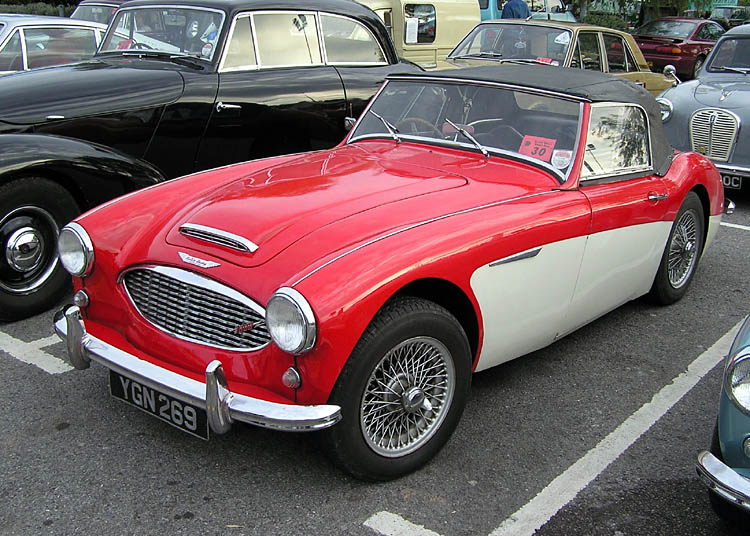The original ‘Healey 100’ began as a private venture from Donald Healey’s small company, and was supposed to use Austin/BMC running gear. However, as soon as that company’s chairman, Len Lord, saw the car, he tied up a deal with Healey – that the car would be manufactured by BMC at Longbridge, that its name would be changed, and that the Healey company would be retained as sports car design consultants thereafter. First deliveries of Austin-Healey 100s followed in 1953.
From 1952 to 1956 these four-cylinder cars sold well, especially in the USA. They were then re-engineered with BMC’s new six-cylinder engine, becoming the ‘100 Six’. Three years later, with an enlarged engine, the same cars were rebadged as the ‘3000’, which it remained for the next eight years. In 1957 final assembly was moved to the MG factory at Abingdon, two-seater or 2+2-seat options were made available, along with optional hard-tops, optional overdrive, single or duo-tone colour schemes, and a mass of accessories.
Earlier cars were raced at Le Mans and Sebring, and were used in a number of high-profile long distance record attempts. Healey produced more and more, performance-raising options. By the 1960s in much-modified and ‘works’ prepared form, the 3000 was a formidable rally car, and a good sports car racer, its most famous achievement when Pat Moss (Stirling’s sister) won the gruelling Liège-Rome-Liège Rally of 1960.



 Austin Healey SpriteAustin-Healey Sprite (Mark III, Mk III) Parts 2Picture Of Austin Healey SpriteAustin Healey SpriteAustin-Healey Sprite (Mark III, Mk III) Parts 2It has been suggested here that there was a "short run of vehicles (unknown number) in late 1963 with the Austin Healey Sprite Mk II body/interior but with the Austin Healey Sprite Mk III undercarriage/suspension modifications". Although no source is given for this assertion, the basis may be more than speculation. There are numerous recorded instances throughout Austin Healey Sprite and Midget production where specification changes do not precisely concur with model changes
Austin Healey SpriteAustin-Healey Sprite (Mark III, Mk III) Parts 2Picture Of Austin Healey SpriteAustin Healey SpriteAustin-Healey Sprite (Mark III, Mk III) Parts 2It has been suggested here that there was a "short run of vehicles (unknown number) in late 1963 with the Austin Healey Sprite Mk II body/interior but with the Austin Healey Sprite Mk III undercarriage/suspension modifications". Although no source is given for this assertion, the basis may be more than speculation. There are numerous recorded instances throughout Austin Healey Sprite and Midget production where specification changes do not precisely concur with model changes
 If standard production types had a problem, it was that they were a little too low slung, and that they passed far too much engine heat into the cockpit, but in view of their style, their performance and their character, enthusiasts forgave them everything. From 1962, in any case, the body was re-engineered with wind-up windows and a curved screen, while from 1964 the interior was also rejigged and the ground clearance raised.
If standard production types had a problem, it was that they were a little too low slung, and that they passed far too much engine heat into the cockpit, but in view of their style, their performance and their character, enthusiasts forgave them everything. From 1962, in any case, the body was re-engineered with wind-up windows and a curved screen, while from 1964 the interior was also rejigged and the ground clearance raised.The last of all, the Mk IIIs, were the best. In total, there were more than 58,000 six-cylinder engined cars, and more than 73,000 of all types. Every six-cylinder car had the same butch character, made all the right noises when pressed hard, and had the same sort of rugged dependability which sports car enthusiasts enjoyed.









No comments:
Post a Comment